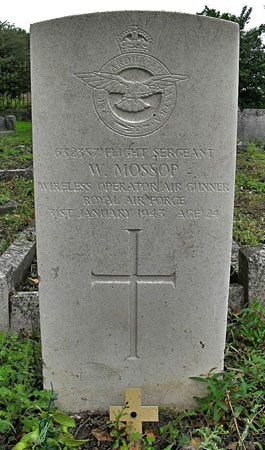Wellington HE173 near Dishforth.
During the early hours of 31st January 1943 this 428 Squadron was undertaking a night circuit flying exercise using Dishforth airfield in stead of their home airfield of Dalton. The aircraft had been flown on a cross country flight earlier that night before landing and the crew reporting no issues with the aircraft. This crew had already made three good take offs and landings from Dishforth. At 02.12hrs they began a fourth, having just become airborne it climbed normally to between 300 and 500 but then lost height gradually until it struck the ground just north east of the airfield. The site was near Lingham Lane Farm and three of those on board died. It was thought that the pilot was pre-occupied in making sure that the flaps and undercarriage was raised after take off and he forgot to keep the aircraft's nose up. The rear gunner was the only survivor. This accident was the first fatal accident 428 Squadron had sustained since it formed in November 1942.
Wellington HE173 was built to contract B.124362/40 by Vickers Armstrong's Ltd. at Hawarden and was awaiting collection in November 1942. It was taken on charge by 428 Squadron at Dalton on 8th December 1942. As a result of the crash on 31st January 1943 Cat.E2/FA Burnt damage was recorded after assessment and it was written off.
Pilot - F/O Norman Gorick RAFVR (124505), aged 21, of Eccles. Buried Worsley Churchyard, Lancashire.
Navigator - F/O George Wood RCAF (J/10688), aged 26, of Toronto, Ontario, Canada. Buried Scholemoor Cemetery, Bradford, Yorkshire.
Wireless Operator / Air Gunner - F/Sgt William Mossop RAF (632357), aged 24, of Meadowfield, Durham. Buried Meadowfield Cemetery, Brandon and Byshottles, Durham.
Air Gunner - Sgt John Welsh RAFVR (1029331). Burns to hands, legs and face.
Norman Gorick begun working for the Prudential Assurance Co.Ltd upon leaving school and joined the Home Guard at the start of the War. After enlisting into the RAFVR he trained in the USA and was awarded his Wings in April 1942. He received a commission on 1st May 1942 to the rank of P/O on probation (emergency) and was promoted to F/O on probation (war subs) on 1st November 1942. Having returned to the UK in June 1942 his obituary printed in the Salford newspaper states that he began operational flying then though this would seem very unusual. At
the time of his death his brother Harry Gorick was serving in the RAF. Norman Gorick is commemorated on the Worsley Methodist Church War Memorial, a church he had attended.
The photograph of him shown above was found on "http://salfordwarmemorials.proboards.com" forum and posted by "Shred".
William Mossop's grave.


George Wood was born on 12th January 1917 in Toronto, Ontario, Canada and was the son of Charles and Agnes (nee Harrison) Wood. Both his parents were born in England but had emigrated to Canada. As a young man he worked as a clerk and machine operator for the Evening Telegram Agency. He was Scoutmaster of 135 Toronto Troop Scouts. He enlisted for RCAF service in Toronto on 19th May 1941 and after training in Canada he was awarded his air observer's flying badge on 14th February 1942. SHortly afterwards he married Eileen Maude Williams and also received a commission in March 1942. Posted to the UK in June 1942 he trained at 10 (O)AFU and 14 OTU before posting to 428 Squadron on 10th November 1942.

John Welsh was initially treated at the sick quarters at Dishforth but was then transferred to Harrogate Hospital on 21st January 1943 and then to Rauceby RAF hospital on 17th March 1943. Because of the burns he received he was then taken to East Grinstead Hospital in April 1943 and he became one of the famous Guinea Pig patients.